A quick birthday-city trip in January. We didn’t feel like going very far or long away, and for once didn’t want to take a plane. So Rotterdam was a logical choice! Only 2,5 hours by train from Ghent, and not too expensive either. This city with over 600.000 inhabitants has the second largest harbor of the world. It was completely destroyed during the Second World War but not reconstructed, which results in an architectural (read: modern) paradise with very few ‘old’ buildings.
We arrived around 9am in Rotterdam Central Station. Wauw! Big, spacious, modern and clean. This site 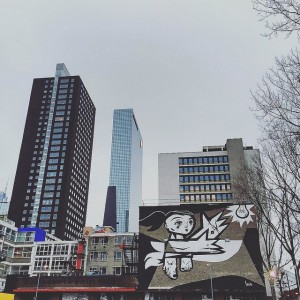 has been completely renovated and expanded during a decade. The new station is only open since 2014. First stop was the tourist information center. Really, you cannot miss it! Near the main entrance with big letters on top 🙂 We bought our Rotterdam Welcome cards for 2 days (cost € 16 per person). Usually, we don’t buy tourist cards. One should always know beforehand if it is worth the money or not. The more you intend to use public transport, enter museums and other attractions, the more profitable such a card is. This means some planning ahead!
has been completely renovated and expanded during a decade. The new station is only open since 2014. First stop was the tourist information center. Really, you cannot miss it! Near the main entrance with big letters on top 🙂 We bought our Rotterdam Welcome cards for 2 days (cost € 16 per person). Usually, we don’t buy tourist cards. One should always know beforehand if it is worth the money or not. The more you intend to use public transport, enter museums and other attractions, the more profitable such a card is. This means some planning ahead!
The first impression when we walked outside the station gave a pretty good impression of the rest of Rotterdam. Lot’s of high (from what height equals ‘high’ ‘skyscraper’?) and modern buildings, with open spaces in between. We headed to the ‘Luchtsingel’ first. It is a footbridge, but we stayed at the beginning of the bridge. Not because we were not curious to see where it goes, but because the weather decided to be a big disappointment for the rest of the morning … The area around the Luchtsingel was neglected for years, but a revaluation is going on, meaning alternative shops and alternative art. Just as we like it, but a thorough research will be for a warmer and dryer day.
We changed our planning, and decided to go to the market first. This is not just an average covered market … The building opened in 2014 and is the first covered market of the Netherlands. But on top of it, it houses the biggest art work in the world: the Horn of Plenty. It is a huge piece of colorful drawings on the 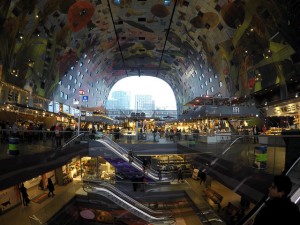 ceiling, and actually best to be seen by night. The building is an arch which houses units, the hollow part is the market … Pretty amazing! The market hall is also built on the place where Rotterdam was ‘founded’ – De Rotte, in the 13th Century. About the only really old building is just meters away from here: the Laurens Church, or the ‘Big Church’. It was built around the 15th Century, and is still standing strong between all these architectural youngsters. Since the weather was still not clearing, we decided to have our lunch inside one of Holland’s most iconic shopping centers: ‘De Bijenkorf’.
ceiling, and actually best to be seen by night. The building is an arch which houses units, the hollow part is the market … Pretty amazing! The market hall is also built on the place where Rotterdam was ‘founded’ – De Rotte, in the 13th Century. About the only really old building is just meters away from here: the Laurens Church, or the ‘Big Church’. It was built around the 15th Century, and is still standing strong between all these architectural youngsters. Since the weather was still not clearing, we decided to have our lunch inside one of Holland’s most iconic shopping centers: ‘De Bijenkorf’.
Rotterdam is built around the banks of the Nieuwe Maas, so counts some bridges … The most spectacular one must be the Erasmus bridge, or ‘The Swan’. This bridge leads you towards the area ‘Kop van Zuid’. One building jumps out: the New York Hotel. The former headquarters of the Holland-America line is a square 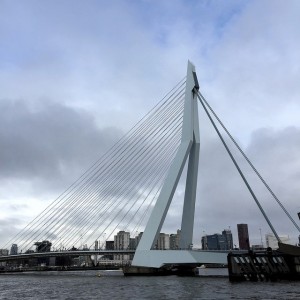 block from where people left their home country towards the New World. Las Palmas is another memory of this past. Sounds more exotic than it is! This used to be a packing house, but now serves as the home of the Dutch Fotomuseum. Well … As Belgians we had to come all the way to the Netherlands to visit an exhibition hosted by the Belgian photographer Stephan Vanfleteren :-).
block from where people left their home country towards the New World. Las Palmas is another memory of this past. Sounds more exotic than it is! This used to be a packing house, but now serves as the home of the Dutch Fotomuseum. Well … As Belgians we had to come all the way to the Netherlands to visit an exhibition hosted by the Belgian photographer Stephan Vanfleteren :-).
When we organized this trip, we thought we would have to walk very far in between sightings, or make expansive use of the (very well organized!) public transport. But all in all, everything is rather close to each other. What made us go to the floating pavilion (Drijvend Paviljoen), literally a floating (but not drifting) exhibition space, where we entered because no one closed the door. Hahaa, that was not the intention 🙂 But we were still welcome to have a look anyway. Back to the bridges then … The railway lifting bridge or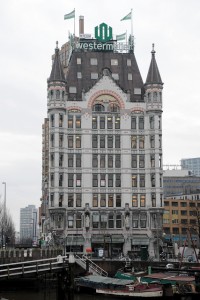 Koninginnebrug was a strange looking bridge, because the middle (the lifting part) was missing (due to renovation). The Willemsbrug took us back to the city center. We thought it was a little bit strange to learn this bridge was named exactly the same as the original one it replaced. But still impressive! One of the architectural highlights of our visit was most definitely a visit to the Kubus-houses.
Koninginnebrug was a strange looking bridge, because the middle (the lifting part) was missing (due to renovation). The Willemsbrug took us back to the city center. We thought it was a little bit strange to learn this bridge was named exactly the same as the original one it replaced. But still impressive! One of the architectural highlights of our visit was most definitely a visit to the Kubus-houses.
Yes, houses in the form of a cube, built on poles, according to the architect a wood of houses and the new way of living in cities (but that was back in the seventies). One of these strange-looking things is open to the public, and yes, they are as small at the inside as they look at the outside! Not our cup of tea but inventive anyway! Across the cubes another old house is worth a stop: the White House (het Witte Huis). Perhaps not as impressive as its namesake, but remarkable. The construction caused a lot of problems for the houses around and the walls of the river, and it wasn’t a big success either as an office building. It was even endangered with demolishing, but today we can still have a look at the ‘White House of Holland’.
Rotterdam at night is a must! The Erasmus bridge and the Markthal are definitely picture-perfect in the dark!
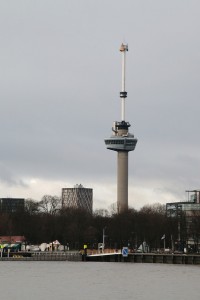 The highlight (literally) of our visit was most certainly the Euromast. This is the highest tower of the Netherlands, with 185m! It is not a cheap attraction, but absolutely well-spent money! The elevator takes you to a first platform, from where the view over the city and the wide environment is just mesmerizing! The stairs or a second elevator take you one level up. There you have to wait maximum 7 minutes for the most spectacular part of your visit: a rotating lift/platform which gives you a 360° view from 185 meters … And although we found it very cold, and it rained at times, this weather was actually contributing to an experience we won’t forget.
The highlight (literally) of our visit was most certainly the Euromast. This is the highest tower of the Netherlands, with 185m! It is not a cheap attraction, but absolutely well-spent money! The elevator takes you to a first platform, from where the view over the city and the wide environment is just mesmerizing! The stairs or a second elevator take you one level up. There you have to wait maximum 7 minutes for the most spectacular part of your visit: a rotating lift/platform which gives you a 360° view from 185 meters … And although we found it very cold, and it rained at times, this weather was actually contributing to an experience we won’t forget.
Conclusion? We probably go back in summer time, to do some more urban exploring in dry and warm weather 😉
a few interesting articles: Rotterdam: the city of the future?
Rotterdam from Travel for Motion on Vimeo.
